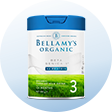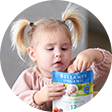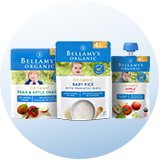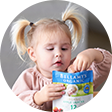Guide to food textures
Your baby needs a variety of food textures and practice before they can eat family food. Including a variety of food textures when introducing solids is important as it helps them learn how to chew, aids speech development and encourages your child to accept different textures. Babies need practise before they can eat family foods.
Delaying texture progression can cause fussy eating habits that may continue throughout life. So here we break down texture by age, but remember every baby is different so it’s important to let them guide you.
Birth- around 6 months
Liquids only
6-7 months
Given your baby has only had milk for the first six months of their lives, it makes sense that the first food offered in the beginning should be pureed and mashed. Every baby is different though, so whilst some may prefer pureed foods, others may be happy to begin with semi-solid or finger foods.
Examples of pureed and mashed foods include:
- Iron-fortified baby cereal
- Pureed well-cooked meat, chicken or fish (no bones)
- Pureed cooked legumes
- Mashed tofu
- Smooth cooked veggies – potato, pumpkin, carrot or broccoli
- Mashed avocado
- Smooth cooked fruit – apple or pear
- Finely mashed soft fruit – banana, mango or avocado
- Full fat yoghurt, smooth cheese and custard
Foods of various textures and thickness can be gradually introduced after your baby is taking well to eating.
If you do start with pureed foods, increase the texture to mashed and soft pieces over a couple of weeks. This will help your baby to be exposed to a variety of textures and encourage chewing. You can also use a combination of textures in one meal. But don’t combine textures in one mouthful as your baby won’t be ready for the texture change.
When giving food with lumps, your baby may spit it out or even gag the first few times. This does not mean they are not ready, they just need to keep practising!
Once your baby has mastered each texture, increase to minced and chopped. These are foods that have been roughly mashed or crumbled. There may be a combination of different sized lumps which are obvious and prominent. Even babies without teeth can manage these foods – all they need is practice!
Examples of minced and chopped foods include:
- Minced or finely chopped meat or chicken
- Mashed or diced vegetables
- Chopped soft raw fruit such as melon and banana
- Yoghurt with soft lumps
- Bread soaked in casserole juices
- Soft scrambled eggs or soft-boiled eggs
Offer lots of different foods for your baby to practice eating in different sizes and textures.
8-12 months
By eight months, most babies can manage finger foods. These are foods that can be picked up and require some chewing. Babies enjoy picking up food with their hands and eating by themselves. These foods break down easily to small pieces in the mouth when chewing.
Examples of finger foods include:
- Bread or toast cut into strips
- Cooked pasta shapes
- Squares of soft cheese
- Soft cooked green beans
- Strips of well-cooked meat and chicken
- Tuna in water
- Chopped soft fruit like banana or strawberry
- Sticks of cooked vegetables like pumpkin or potato
12 months onwards
By the time your baby is 12 months old, they should be eating the same foods that the rest of the family is eating. These may contain more than one consistency. You might still need to chop some foods into smaller pieces and cook vegetables until they’re soft. Remember, small hard foods such as whole nuts, raw carrot or apple pieces should not be given to children under three.
Examples of family foods include:
- Casserole (meat and sauce)
- Roast meat and vegetables
- Pasta or stir fry
- Dry cereal with milk
- Vegetable or noodle soup
- Fruit yoghurt
- Cooked vegetables or salad
- Sandwiches
If your child is having difficulty progressing through textures, talk to your child health nurse or GP. You may be referred to a dietitian or speech/language specialist for further help.
Babies are adventurous eaters so let them time to explore and develop at their own pace. Enjoy watching them quickly learn to manage food of different textures. Don’t worry if your baby doesn’t take much to begin with, they just need lots of practice!
References:
1. National Health and Medical Research Council. (2013). Eat for Health – Infant Feeding Guidelines Information for Health Workers. Available from: https://www.nhmrc.gov.au/about-us/publications/infant-feeding-guidelines-information-health-workers
































